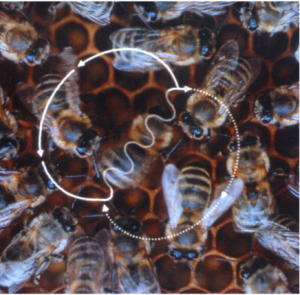That pot of honey on the table, yes, that sticky pot with the knife in it. Not many of us give a second thought to the origin of this breakfast staple, let alone to the organisms that make it. Perhaps you do know, however, that bees dance. Before images of breakdancing bees cross your mind, I need to clarify that these dances are composed of a rigid set of movements that bees make in order to communicate with one another. So how are these dances used to form a ‘language’?
Bees live in a colony in which there is one fecund female, the queen, a few hundred male ‘drones’ and thousands of sterile worker females who forage to feed the colony’s offspring. If a foraging female finds a food source within 100m of the hive, she returns and performs the ‘round dance’ in which the bee waggles her abdomen and emits sounds. Potential foragers within the hive then receive food and follow her around in the dance. This results in other workers going out to forage within close proximity of the nest.

Source: Fir0002/Flagstaffotos
However, if the food source is further than 100m away, then the bee performs a ‘waggle dance’ which involves the bee making a figure of eight, waggling its abdomen in the straight, central section. The speed at which this waggle dance is performed is inversely proportional to the distance of the food source from the hive, and the length of time over which the bee performs the dance is proportional to how abundant the food source is. The angle at which the waggle dance is performed within the nest with regards to the vertical is the same as the angle of the food source compared to the sun’s azimuth from the hive. The waggle dance therefore directs other foragers in the direction of the new food source. However, if the brood is well fed and it is no longer necessary to collect more food, then there are fewer worker bees available to receive food from a returning bee. In this instance, the foraging bee will switch from the waggle dance, to the ‘tremble dance’ in which the bee performs lateral and rotational vibrations, changing angle repeatedly. This tremble dance is performed deeper within the hive and acts as an inhibitory dance, causing workers to carry out domestic duties rather than being recruited to foraging for the hive.

The Waggle Dance (Source: J. Tautz and M. Kleinhenz, Beegroup Würzburg)
When a colony becomes too large it will split, with two separate queens; the waggle dance can also be used within this context. Scouts returning from potential nest sites will perform the waggle dance in order to recruit other scouts to visit that site. The longer the scout performs the waggle dance, the better she thinks that the site is. Once a certain number of scouts are visiting the same nest site, workers from the temporary site will move to this new site, establishing a new colony through this collective decision.
As you can see, these dance signals are complex, particularly the waggle dance and are therefore claimed to be a ‘language’ amongst bees. So the next time you’re tucking into that bowl of crunchy nut, remember the bees and their dance moves involved in curing your mid-morning hunger, and maybe a shimmy or two wouldn’t be too out of order.